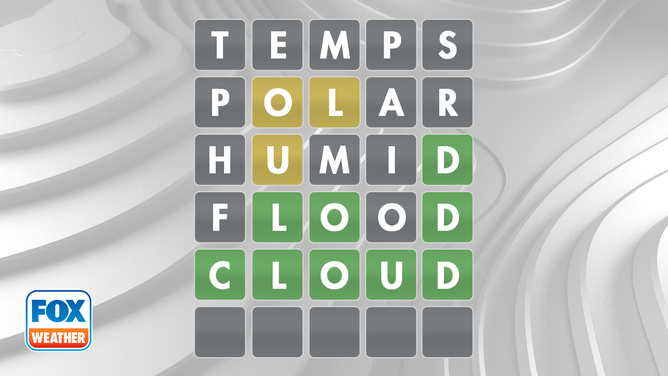Weather Wordle: Meteorology vocab to help solve game on everyone's R-A-D-A-R
Take your Wordle game to the next level with dozens of these five-letter weather words
An addictive online game taking the world by S-T-O-R-M probably has you and your friends hooked by now.
For those that play, the word-guessing brainteaser is already on your R-A-D-A-R without us having to mention the game’s name.
The object of Wordle is simple: correctly identify the five-letter English language word in less than six tries. But don’t let your head S-T-E-A-M.
While there are no prizes, the ultimate H-I-G-H-S and I-C-I-N-G on the cake are bragging rights that come from guessing it on the first attempt.
After each guess, W-A-T-C-H as the color of the tiles (green, gray and yellow) changes to show how close your guess was to the word. Get five green tiles, and you win.
Developed by Josh Wardle, a software engineer in Brooklyn, Wordle was recently acquired by the New York Times for A-L-O-F-Ty (see what we did there?) price "in the low seven figures," the newspaper said. The game with millions of daily users remains free to new and existing players.
Throughout this story, we have given you a F-L-A-S-H of five-letter weather words that we use in our line of work each day. Here are 20 more words that might take your Wordle into S-P-A-C-E.

(FOX Weather)
CELLS – Convection in the form of a single updraft, downdraft, or updraft/downdraft couplet, typically seen as a vertical dome or tower as in a towering cumulus cloud. A typical thunderstorm consists of several cells.
CHILL – Reference to the wind chill factor; increased wind speeds accelerate heat loss from exposed skin, and the wind chill is a measure of this effect. The threshold for potentially dangerous wind chill conditions is about minus 20 degrees.
CLOUD – A visible aggregate of minute water droplets or ice particles in the atmosphere above the Earth's surface.
CRAFT – There is no precise definition for small craft. Any vessel that may be adversely affected by Small Craft Advisory criteria should be considered a small craft.
FLOOD – Any high flow, overflow, or inundation by water that causes or threatens damage.
FRONT – A boundary or transition zone between two air masses of different densities and usually of different temperatures. A moving front is named according to the advancing air mass, like a cold front if colder air is advancing.
FROST – Frost describes the formation of thin ice crystals on the ground or other surfaces in the form of scales, needles, feathers or fans.
GUSTS – A rapid fluctuation of wind speed with variations of 10 knots or more between peaks and lulls.
NATIONAL PUNCTUATION DAY: AMERICA'S FAVORITE PUNCTUATION MARK IS ALSO A TYPE OF CLOUD
HUMID – Generally, a measure of the water vapor content of the air. Popularly, it is used synonymously with relative humidity.
MODEL – A climate model is a mathematical model for quantitatively describing, simulating, and analyzing the interactions between the atmosphere and underlying surface.
OZONE – A form of oxygen, O3. A powerful oxidizing agent that is considered a pollutant in the lower troposphere but an essential chemical in the stratosphere where it protects the earth from high-energy ultraviolet radiation from the sun.
RAINS – Precipitation that falls to earth in drops more than 0.5 mm in diameter.
SCALE – As in the Fujita scale which is the scale of tornado intensity in which wind speeds are inferred from an analysis of wind damage.
SLEET – Pellets of ice composed of frozen or mostly frozen raindrops or refrozen partially melted snowflakes.
SMOGS – Air that has restricted visibility due to pollution or pollution formed in the presence of sunlight.
SNOWS – Precipitation in the form of ice crystals, mainly of intricately branched, hexagonal form and often agglomerated into snowflakes, formed directly from the freezing of the water vapor in the air.
TEMPS – The temperature is a measure of the internal energy that a substance contains.
WARNS – A warning is issued when a hazardous weather or hydrologic event is occurring, is imminent, or has a very high probability of occurring. A warning is used for conditions posing a threat to life or property.
WEDGE – The term "wedge" often is used somewhat loosely to describe any large tornado. However, not every large tornado is a wedge. A true wedge tornado, with a funnel at least as wide at the ground as it is tall, is very rare.
WINDS – The horizontal motion of the air past a given point.